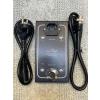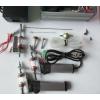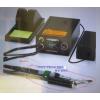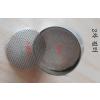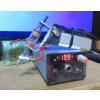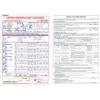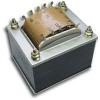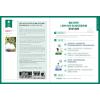마침 미국의 한 캐파시터 회사의 요약설명서가
지금껏 본 중에서 가장 간명하게 되어 있어서 소개합니다.
번역은 안했습니다. 거의 쉽고 의미전달 잘되는 수준의 영어로 보여서....
이 설명에서도 보여지듯,
가장 비용 대비 효과가 좋은 것은 폴리에스터인 것 같고,
가격과 제반 조건을 떠나서 가장 좋은 재질은 테플론입니다.
<캐퍼시터의 재질 비교>
FIXED FILM CAPACITOR DIELECTRICS
Polyester (Mylar) Film:
A good general purpose plastic dielectric with relativity low cost and high volumetric efficiency.
Still the most popular of the capacitor dielectrics.
Available in both Metallized Polyester Film and Polyester Film & Foil designs.
Combination Film:
Combination Polyester (Mylar) and Polypropylene.
Extremely low temperature coefficient in the 0° C to 85° C temperature range.
Volumetric efficiency similar to Polycarbonate.
Available in both Metallized and Foil designs.
KF (Polymer) Film:
Extremely high volumetric efficiency with about 4 times the "K Factor" of mylar,
making it about 1/4 the size.
Higher DF and lower IR are its disadvantages along with cost.
Polycarbonate Film:
Lower DF, higher IR, better temperature coefficient and better stability than mylar
with a slightly lower volumetric efficiency.
Second most popular Dielectric.
Available in both Metallized Polycarbonate Film and Polycarbonate Film & Foil designs.
Polycarbonate capacitors have a 100% voltage rating from -55° C to +125° C.
Kapton Film:
Electrical properties similar to Mylar with a much higher operating temperature
going up to 250° C. A higher cost than mylar limits its use.
Polypropylene Film:
Very good temperature coefficient high IR, and low DF make it good for AC operation.
Usable to 105° C without derating.
Has become increasingly popular for AC applications.
Available in both Metallized Polypropylene Film and Polypropylene film & Foil constructions.
Polysulfone Film:
Electrical properties similar to polycarbonate with a very good temperature coefficient
and higher operating temperature.
Very limited availability in the last few years has limited its use.
Available in both Metallized Polysulfone Film and Polysulfone Film & Foil designs.
Polystyrene Film:
Very good electrical properties and excellent stability are its advantages.
Its big disadvantage is its operation is limited to below 85° C
and it is available in Polystyrene Film & Foil construction only.
Super Metallized Polypropylene Film:
A very high current design for very high frequencies up to 1 Megahertz.
The ultimate in high current capacitors. They are used for input filtering, high frequency
transformer DC blocking and output filtering.
They are dry-section non-polar metallized film dielectric with special high current end
terminations resulting in very low ESR values and very high DV/DT ratings.
Larger than SuperMetallized Polypulse. Also popular in snubber applications.
SuperMetallized Polypulse Film:
Developed by American Capacitor specifically for switching power supply type applications.
They are used for input filtering, high frequency transformer DC blocking and output filtering.
They are dry-section non-polar metallized film dielectric with special high current end
terminations resulting in very low ESR values and very high DV/DT ratings.
They are significantly smaller than metallized polypropylene capacitors and
have a 100% voltage rating from -55° C to +125° C.
Capacitance change over temperature is 4 times better than with polypropylene.
Teflon Film:
The best electrical properties of all the Dielectrics.
Extremely high IR, low DF and operation to 250° C.
Available in both Metallized Teflon Film and Teflon Film & Foil constructions.
Paper Film:
Paper or Kraft Paper is the oldest of the film capacitor dielectrics.
It is available in both Metallized Paper and Paper & Foil constructions.
The paper must be impregnated with Epoxy, Wax, Oil, or other suitable impregnate.
It is still popular for high voltage and AC rated capacitors operating at lower frequencies.
Paper is also wound with plastic dielectrics in combination dielectric capacitors.
지금껏 본 중에서 가장 간명하게 되어 있어서 소개합니다.
번역은 안했습니다. 거의 쉽고 의미전달 잘되는 수준의 영어로 보여서....
이 설명에서도 보여지듯,
가장 비용 대비 효과가 좋은 것은 폴리에스터인 것 같고,
가격과 제반 조건을 떠나서 가장 좋은 재질은 테플론입니다.
<캐퍼시터의 재질 비교>
FIXED FILM CAPACITOR DIELECTRICS
Polyester (Mylar) Film:
A good general purpose plastic dielectric with relativity low cost and high volumetric efficiency.
Still the most popular of the capacitor dielectrics.
Available in both Metallized Polyester Film and Polyester Film & Foil designs.
Combination Film:
Combination Polyester (Mylar) and Polypropylene.
Extremely low temperature coefficient in the 0° C to 85° C temperature range.
Volumetric efficiency similar to Polycarbonate.
Available in both Metallized and Foil designs.
KF (Polymer) Film:
Extremely high volumetric efficiency with about 4 times the "K Factor" of mylar,
making it about 1/4 the size.
Higher DF and lower IR are its disadvantages along with cost.
Polycarbonate Film:
Lower DF, higher IR, better temperature coefficient and better stability than mylar
with a slightly lower volumetric efficiency.
Second most popular Dielectric.
Available in both Metallized Polycarbonate Film and Polycarbonate Film & Foil designs.
Polycarbonate capacitors have a 100% voltage rating from -55° C to +125° C.
Kapton Film:
Electrical properties similar to Mylar with a much higher operating temperature
going up to 250° C. A higher cost than mylar limits its use.
Polypropylene Film:
Very good temperature coefficient high IR, and low DF make it good for AC operation.
Usable to 105° C without derating.
Has become increasingly popular for AC applications.
Available in both Metallized Polypropylene Film and Polypropylene film & Foil constructions.
Polysulfone Film:
Electrical properties similar to polycarbonate with a very good temperature coefficient
and higher operating temperature.
Very limited availability in the last few years has limited its use.
Available in both Metallized Polysulfone Film and Polysulfone Film & Foil designs.
Polystyrene Film:
Very good electrical properties and excellent stability are its advantages.
Its big disadvantage is its operation is limited to below 85° C
and it is available in Polystyrene Film & Foil construction only.
Super Metallized Polypropylene Film:
A very high current design for very high frequencies up to 1 Megahertz.
The ultimate in high current capacitors. They are used for input filtering, high frequency
transformer DC blocking and output filtering.
They are dry-section non-polar metallized film dielectric with special high current end
terminations resulting in very low ESR values and very high DV/DT ratings.
Larger than SuperMetallized Polypulse. Also popular in snubber applications.
SuperMetallized Polypulse Film:
Developed by American Capacitor specifically for switching power supply type applications.
They are used for input filtering, high frequency transformer DC blocking and output filtering.
They are dry-section non-polar metallized film dielectric with special high current end
terminations resulting in very low ESR values and very high DV/DT ratings.
They are significantly smaller than metallized polypropylene capacitors and
have a 100% voltage rating from -55° C to +125° C.
Capacitance change over temperature is 4 times better than with polypropylene.
Teflon Film:
The best electrical properties of all the Dielectrics.
Extremely high IR, low DF and operation to 250° C.
Available in both Metallized Teflon Film and Teflon Film & Foil constructions.
Paper Film:
Paper or Kraft Paper is the oldest of the film capacitor dielectrics.
It is available in both Metallized Paper and Paper & Foil constructions.
The paper must be impregnated with Epoxy, Wax, Oil, or other suitable impregnate.
It is still popular for high voltage and AC rated capacitors operating at lower frequencies.
Paper is also wound with plastic dielectrics in combination dielectric capacitors.
